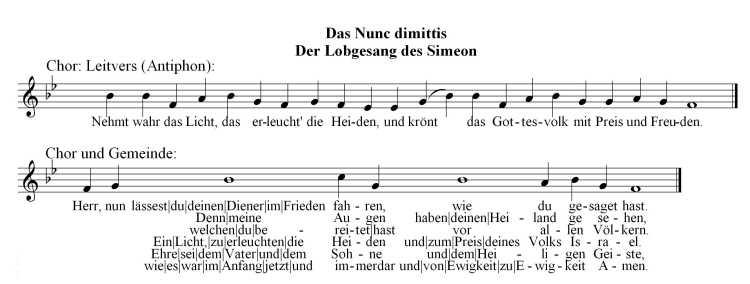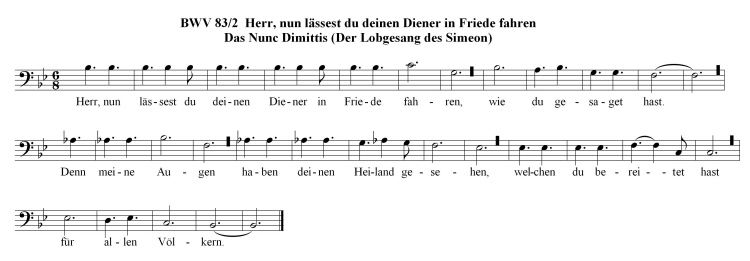|
|
Chorale Melodies used in Bach's Vocal Works
Das Nunc dimittis |
|
Melody & Text | Use of the CM by Bach | Use of the CM by other composers |
| |
|
Melody & Text: Zahn: ? | EKG: Lit. 27 |
|
This is one of the special “Liturgische Gesänge” (“songs of Liturgy”) included in a separate section of the currently-used hymnal of the Evangelical-Lutheran Church in Germany and is found in the Order of Vespers with the number 27 assigned to it.
The melody/antiphon is intended as a response to the choir’s singing of the “Leitvers” (“the leading-in verse”) which prepares the beginning of the Nunc dimittis by having the choir sing to the congregation: “Become aware of the Light which (will) (en)lighten(s) the heathens/unbelievers.” After this the choir and congregation sing together the “Song of Simeon” taken from the New Testament Gospel of Luke 2:25-31.
Luther Unrevised 1545: >>Und siehe, ein Mensch war zu Jerusalem mit Namen Simeon; und derselbe Mensch war fromm und gottesfürchtig und wartete auf den Trost Israels; und der Heilige Geist war in ihm. Und ihm war eine Antwort worden von dem Heiligen Geist, er sollte den Tod nicht sehen, er hätte denn zuvor den Christ des HErrn gesehen. Und kam aus Anregen des Geistes in den Tempel. Und da die Eltern das Kind JEsus in den Tempel brachten, daß sie für ihn täten, wie man pfleget nach dem Gesetz, da nahm er ihn auf seine Arme und lobete GOtt und sprach: HErr, nun lässest du deinen Diener im Frieden fahren, wie du gesagt hast; denn meine Augen haben deinen Heiland gesehen, welchen du bereitet hast vor allen Völkern, ein Licht, zu erleuchten die Heiden, und zum Preis deines Volks Israel.<<
New Living Translation: >>Now there was a man named Simeon who lived in Jerusalem. He was a righteous man and very devout. He was filled with the Holy Spirit, and he eagerly expected the Messiah to come and rescue Israel. The Holy Spirit had revealed to him that he would not die until he had seen the Lord's Messiah. That day the Spirit led him to the Temple. So when Mary and Joseph came to present the baby Jesus to the Lord as the law required, Simeon was there. He took the child in his arms and praised God, saying, "Lord, now I can die in peace! As you promised me, I have seen the Savior you have given to all people. He is a light to reveal God to the nations, and he is the glory of your people Israel!"<<
The EKG explains that the specific melody used can be traced back to a 1566 printing of the largest, most comprehensive hymnal published in German by the Bohemian Brothers.
The tradition of singing the Nunc dimittis, albeit with a different melody, comes from the Medieval Period. There were at that time 9 Psalm tones of which the Nunc dimittis was Psalm Tone No. 8.
The Nunc dimittis or Canticum Simeonis is one of the three Psalm-like verses derived from the New Testament.
Johann Walther, in his “Musicalisches Lexicon….” (Leipzig, 1732) refers to these as the Psalmi majores in contrast to the Psalmi minores which is the name given to David’s Psalms from the Old Testament. In the category of Psalmi majores are found the Magnificat (“Meine Seel erhebt den Herrn”), the Benedictus (Zacharias’ song of praise: “Gelobet sei der Herr, der Gott Israel”) and the Nunc dimittis (Simeon’s song of praise: “Herr, nun lässest du deinen Diener in Frieden fahren” ).
The antiphon melody with its text appears this way today: |
|

|
| |
|
Use of the Chorale Melody by Bach: |
|
Text: Das Nunc dimittis | EKG: Lit. 27
Only the opening two notes on “Herr, nun” differ from Bach’s use of this melody, and these two notes are never repeated during the repetitions of the line. |
|
Ver |
Work |
Mvt. |
Year |
Br |
RE |
KE |
Di |
BC |
Score |
Music Examples |
|
- |
BWV 83 |
Mvt. 2 |
1724 |
- |
- |
- |
- |
A167:2 |
- |
Mvt. 3 (Leusink) [ram] |
|

|
| |
|
Use of the Chorale Melody by other composers: |
|
There are many compositions with the title Nunc dimittis mainly from England and some from Italy and a few other European countries, but, as far as we know, they use Latin texts or the language of the country in which they were composed. Therfore, we decided not to list them here.
In German-speaking countries, there were a few listings, but we are not at all certain whether they are based on this chant-melody. Most probably they are not and may be original compositions using this text, but not referencing the antiphon as used here.
Grove Music Online states that the Nunc dimittis has probably more 'melodies' associated with it than any other antiphon. Calvin published an order of services a few years before the Bohemian Brothers. It could easily be that the Anglican Church received a different melody through Calvin, but this is not certain.
Here are composers of the German tradition of which two use Latin text (most likely with a different melody), but the Schütz looks like it may fit into the mold. |
|
Johann Schelle (1648-1701)
Nunc Dimittis, a 20: all lost, listed in inventories, 1686 and 1712 [entirely in Latin] |
|
Johann Rosenmüller (1615-1684):
Nunc dimittis, 1v, 3 str, bc
Nunc dimittis, 4vv, 5 str, bc [probably in Latin] |
|
Heinrich Schütz (1585-1672):
>>The Musicalische Exequien SWV 279–81 (1636) was commissioned for the funeral of Prince Heinrich Posthumus of Reuss by his widow. Schütz divided the work into three parts. The first, a ‘Concerto in the form of a German burial Mass’, alternates a six-voice tutti texture with duets and trios; the tutti sections, with optional capella reinforcement, are used for the Kyrie text and employed as a refrain. This innovative structural technique is continued in the second part of the ‘concerto’, where the solos correspond to settings of biblical texts and the tuttis to chorale interpolations. Part ii, the double-chorus motet Herr, wenn ich nur dich habe, recalls the antiphonal writing in Gabrieli’s large-scale works and Schütz’s requiem ends with a ‘Concerto for two choruses in which each chorus has its own words’. The SSB trio of the chorus secundus – two seraphims and the ‘beata anima’ – provides an ‘angelic’ gloss on the solemn and registrally dark AATTB quintet of the Nunc dimittis. In the Musicalische Exequien Schütz brought together older compositional techniques (plainchant intonations, modal associations, chorale harmonizations and motet textures) and the modern small concerto and double-chorus concerted style of the last part. They contribute to the varied and serenely intense style of Schütz’s only extended funeral music.
One of the pieces in the group, the German Nunc dimittis SWV 352a, bears a dedication to Christoph Cornet, ‘ever to serve him with greatest affection’; Cornet, who died of the plague shortly before August 2, 1635, had no doubt commissioned the work as his funeral music.
As a final act of duty to the man whom he had served for more than 40 years - and whose passing, despite everything, must have affected him deeply – Schütz composed the twin settings of the German Nunc dimittis SWV 432–3.<<
Grove Music Online |
| |
|
Sources: NBA, vols. III/2.1 & 2.2 in particular [Bärenreiter, 1954 to present] and the BWV ("Bach Werke Verzeichnis") [Breitkopf & Härtel, 1998]
The PDF files of the Chorales were contributed by Margaret Greentree J.S. Bach Chorales
Software: Capella 2004 Software, version 5.1.
Prepared by Thomas Braatz & Aryeh Oron (January 2006) |
|
|